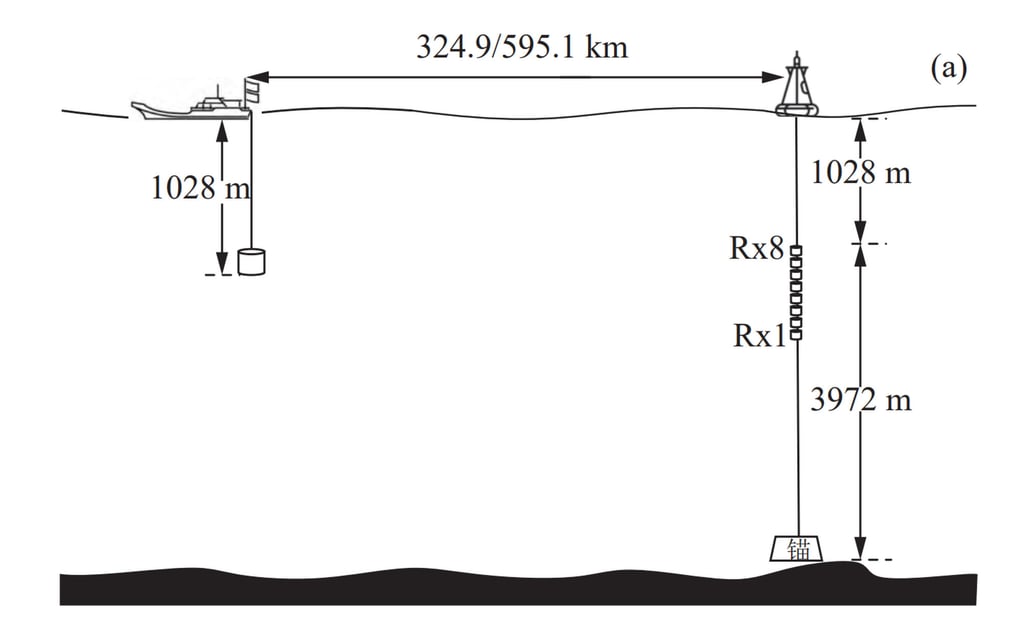
Evelyn Hart
In a test conducted at sea, Chinese researchers say they have achieved what has long eluded scientists in underwater communication: error-free acoustic transmission over a distance of 600 kilometers. The feat, described in a recent paper published in Acta Acustica, represents what they call a major step toward long-range undersea messaging—a technology with potentially wide-ranging implications for both civilian and military use.
A New Frontier in Acoustic Communication
The trials were led by Professor He Chengbing and a research team from Northwestern Polytechnical University in Shaanxi, one of China’s most prominent defense institutions. According to the study, the experiments were carried out in waters with an average depth of approximately 5.5 kilometers (3.4 miles). The researchers employed an eight-element hydrophone array mounted on a buoy and transmitted data using quadrature phase-shift keying (QPSK) signals at a speed of 37.5 bits per second.
What sets this development apart is the claim of a “zero bit error” rate across the entire 600-kilometer distance, the equivalent of the stretch between Taipei and the U.S. military base in Okinawa. While previous efforts—such as a 2010 U.S. Navy experiment—have managed to send signals across similar distances, maintaining data integrity has remained a persistent challenge.

Solving the Chaos Below the Surface
Underwater environments pose daunting technical obstacles to long-range acoustic messaging. Signals are typically scattered into multipath echoes, distorted by Doppler shifts from moving sources, and buried under ambient ocean noise. These phenomena can reduce a signal that begins as a powerful acoustic burst to little more than a whisper after traveling hundreds of kilometers.
To address these issues, He’s team devised a self-tuning system capable of identifying signal clusters in complex, noisy environments without requiring prior knowledge of seabed topography. According to the paper, this flexibility offers a strategic advantage for naval operations in unfamiliar or rapidly changing underwater terrains.
The researchers also introduced a new algorithm that reinterprets the time-varying acoustic channel as a set of quasi-static “acoustic snapshots”. These snapshots make it possible to apply iterative error correction, a technique likened to “sharpening a blurry photo with multiple exposures.”
Tradeoffs in Power and Practicality
Despite its success in controlled trials, the system remains computationally intensive. According to the study, processing a single transmission requires computing power at the teraflop scale, making real-time use on smaller platforms, such as autonomous underwater drones, impractical under current conditions.
The communication system also faces potential disruptions from abrupt environmental changes. Events such as storms or sudden maneuvers by underwater vehicles can quickly alter the signal channel, presenting additional challenges to maintaining stability and clarity in dynamic real-world conditions.
Strategic Implications and Institutional Context
Founded in the 1950s, Northwestern Polytechnical University has played a long-standing role in the development of China’s aerospace and naval research programs. Recognized by Chinese authorities as one of the “Seven Sons of National Defence,” the institution has also been subject to U.S. sanctions and cyberattack allegations, reflecting its growing significance in the country’s defense technology ecosystem.
The study’s results not only claim to advance the frontier of underwater acoustics, but may also carry consequences for how nations project communications capabilities below the ocean surface. According to the South China Morning Post, even slight data corruption is considered unacceptable for sensitive operations such as “awakening dormant underwater drones or synchronising attack coordinates.”
The error-free performance across 600 kilometers, if confirmed and repeatable, could reshape strategic thinking about how information is transmitted and secured underwater. The article appeared in the indiandefencereview
